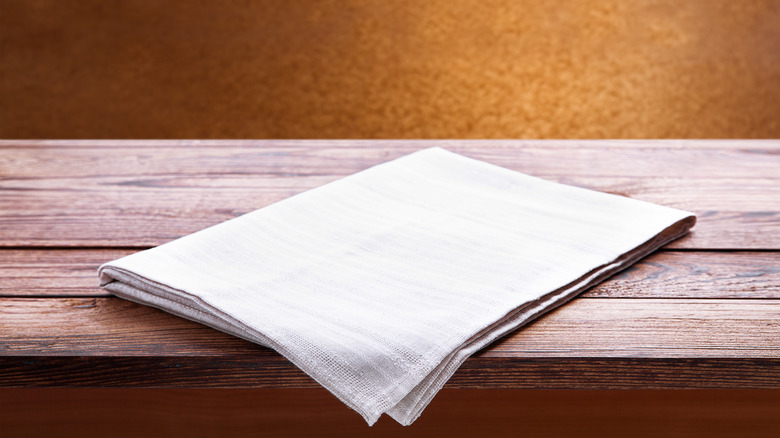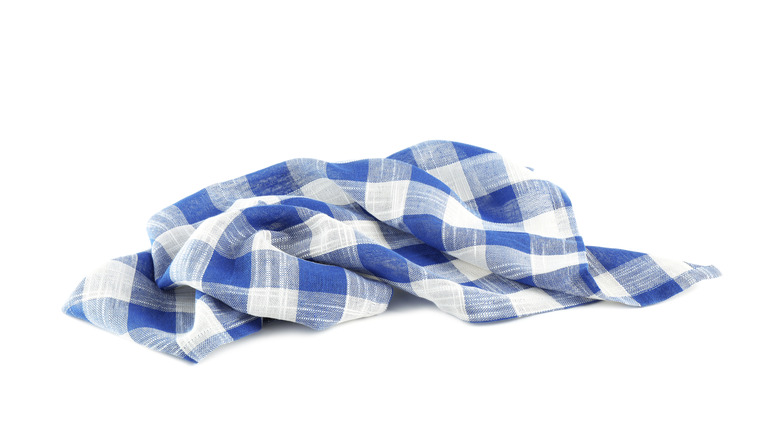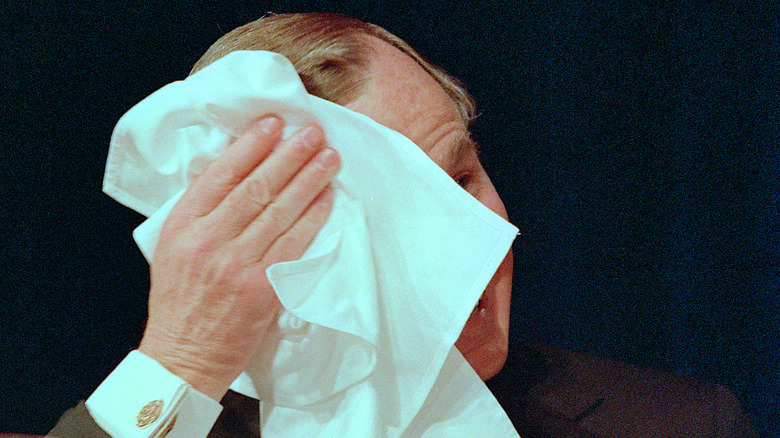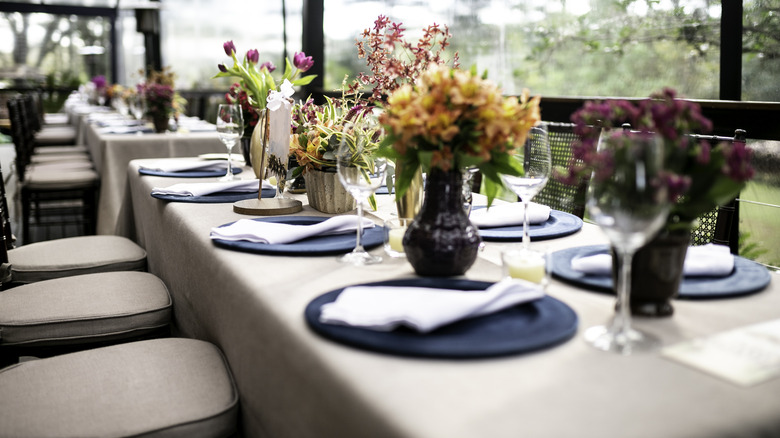8 Restaurant Napkin Etiquette Tips You Should Know
Proper napkin etiquette is important when dining at high-end restaurants. Although certain practices may seem outdated, following a set of norms reflects your respect for the establishment and for good manners in general. While using a napkin may seem straightforward, the small movements surrounding the simple act of picking it up from the table and putting it on your lap can be more consequential than you think -– all told, they signal that you know what you're doing and that you belong in this space.
Of course, the napkin, at its core, is a practical tool. It helps protect your clothing from spills, and it gives you something to blot food from your mouth, other than your sleeve. But each of these movements comes with a set of rules, and if you don't know what they are, you might be heading for a major faux pas. Although it's unlikely that a waiter or sommelier would call you out for something as small as folding your napkin the wrong way, they might notice if you do it right away, and appreciate the gesture. Moreover, the napkin can be used as a silent communication tool with said waiter. For instance, placing your napkin on the chair when you stand up indicates that you plan on returning forthwith while placing it on the table signals you're done with your meal. So let's take a look at the most important things you need to know about handling your napkin at a fancy restaurant.
Don't forget to put the napkin on your lap
While you may or may not be the type of person who places a napkin on their lap when dining at home, you will definitely need to do so at a fancy restaurant. Here, you will not have a chance to just get up and go change if you spill tomato sauce on your pants. Your napkin will be the only thing standing between you and the travesty and embarrassment of a coffee stain.
But how and when you put your napkin on your lap also matters. For instance, you'll need to pay attention to the size of the napkin: A larger one should be folded in half on your lap, while a smaller one should be completely unfurled. This makes sense -– you want to make sure you cover as much of your lap as possible without making it look like you're wearing the tablecloth. As for when this can vary on a case-by-case basis, but generally speaking, you'll want to have your napkin in place by the time you start eating, which includes any bread or canapés. It's typically accepted that you should put your napkin on your lap as soon as you sit down.
Fold the napkin the right way
When dealing with a larger napkin, you're inevitably going to want to fold it at least once before placing it on your lap. Otherwise, it might slip off more easily and end up on the floor — a scenario that has its own set of rules to remember. So make sure that when it's time to take your napkin from the table and put it in its proper place, you fold it once, halfway, with the crease facing inwards.
Now, this fancy restaurant napkin etiquette rule may seem random at first, but let us tell you why it's not. As you can imagine, during the meal, you'll be blotting your mouth with the napkin from time to time, leaving a smudge or a stain on the cloth. This can be unsightly for delicate sensibilities, so you'll want to keep it hidden. According to fine dining rules, which have had centuries to develop, the best way to hide it is to use the inside of your folded napkin to blot your lips. With the correct internal-facing fold, you'll have direct access to the interior of your napkin for this nifty little trick.
When done, fold the napkin over
It seems like napkins in most fine-dining restaurants are mercilessly white. This makes it incredibly easy to spot stains on people's napkins, even if you're trying hard to avert your eyes. And stains abound — no matter how dainty a portion may be, or how orderly its presentation, it's always possible to get a little something on your lips or corner of the mouth as you eat. This is only human.
Luckily, the U.K.'s royal family has a solution to the resulting napkin problem, and, although it might not be part of the official canon, it can certainly help with protecting your honor when it comes to food stains on napkins. The solution in question requires the diner to fold over their napkin when they're done, making sure no one can catch a glimpse of any food stains that might be left inside. No one wants to see that, plus, you don't want anyone clearing your table to have to grab onto a sticky or gooey napkin. In addition, make sure you place that soiled cloth to the left of your plate — this is common etiquette that is not only followed by the royal family. This move categorically indicates that you are done with your meal, signaling to the waiter that you're ready for your plate to be cleared.
Avoid hiding food in your napkin
While it's okay and even preferable to hide food stains in your napkin, there is a line one must not cross as that stain becomes more substantial. To put it more bluntly, you must not hide actual food inside the napkin. If you encounter something that you do not like, there are a number of steps you can take, but spitting it out into your napkin is not one of them. Nor is it acceptable to nudge it away into the napkin directly from the plate. Someone, somewhere, most likely a staff member in the kitchen with their bare hands, will discover what you've done and will not be happy about it.
Instead, you can simply leave that food on the plate, pushing it to the top left corner. This is the designated spot for unwanted food or discarded bones or shells unless a separate plate has been provided specifically for those items. In some cases, you might not like the food because of an oversight in the kitchen. Although it's not necessarily acceptable to point out that you wanted your steak well-done, as this could elicit stink eye from your waiter, especially since the level of doneness should be at the discretion of the chef — if an error was made, because even chefs are human, it is okay to say so and ask for a dish to be taken away, even in a fine dining establishment.
Place your napkin on your chair when rising
If you're at a restaurant to enjoy a tasting menu, some of which easily come to nine courses or even more, you can expect to be sitting at your table for a good three hours. This means that, somewhere along the way, you're probably going to need to get up and use the facilities. That's perfectly fine — when nature calls, and all that. Just don't announce your intention with words. Rather, excuse yourself and place your napkin on your chair. This signals to the server that you will be back soon and that you're not done with your meal.
By contrast, the napkin goes on the table to the left of the plate if you are finished. Also, try to avoid forgetting about your napkin entirely and letting it fall to the floor as you stand up. Your server will likely be the one to have to pick it up. Even so, don't be surprised if you come back to the table with a freshly folded or entirely new napkin. A server at a fine-dining restaurant will likely use your absence to replace your stained napkin or at least fold it back into a neat shape you can once again unfurl and place back on your lap as soon as you return.
Do not pick up a dropped napkin
If you ever happen to drop your napkin on the floor by accident, don't beat yourself up. But, equally, don't try to reach for it yourself. Not because you're above such things, but because it's not exactly becoming to grab a napkin from the not-so-clean floor and then put it on your mouth. Picking up a napkin that has fallen on the floor is just bad restaurant etiquette. While the floor of a fine dining restaurant may appear to be clean, it is a floor after all, and you might have been dropping crumbs there all night without even realizing it, not to mention what might have been dragged over by the sommelier's shoe as they poured you that glass of Champagne
Instead, get your server's attention so that they may pick up the soiled napkin and fetch you a clean one. They have a process for this and even expect it to happen, which is why you should not try to pick up the napkin yourself. You wouldn't be doing anyone any favors. Just make sure you're discreet about the whole affair. This is not the time to be yelling "garçon!" across the room, or flagging anyone down like you're trying to direct air traffic. Just keep an eye out for your server and when they look over your way, give them a polite sign with a nod or a slight hand movement.
Only use a corner to dab at your mouth
Your napkin is given to you at a restaurant for your use alone, but that doesn't mean you should be hogging the whole thing. In fact, etiquette dictates that you should only use a corner of the napkin so that you don't get the whole thing dirty and in need of replacement before the meal is even over. Of course, if you're consuming something really messy or have some kind of accident, no one expects you to clean your mouth with a wet, sticky, part of your napkin. But many dishes in fine dining restaurants are designed to be comfortably bitten into without causing undo messes.
Another thing to remember here is that you should use that corner with care. Don't simply bring it up to your chin and start going to town on whatever is on there. Wiping or rubbing motions will not be tolerated. Instead, carefully dab at whatever is concerning you — it's better to do this for however long it takes to clear the problem than to make a spectacle of your dirty chin. This is also why you should never use that napkin to wipe off sweat or blow one's nose. This is simply too much for polite company. If you need to take care of these inconveniences, it's best to leave the table momentarily and find a tissue in the bathroom.
Follow your host's lead
Although most of the time you'll be dining at a fancy restaurant of your own free will, you might encounter a situation where you were brought there by a host. Perhaps you're at a wedding reception, a work conference, or an award ceremony. In these cases, the polite thing to do is to follow the lead of your host in all dining matters, whether it be sitting down at the table or picking up your fork to start your meal.
This etiquette holds true even when dealing with napkins. To start with, it's best to only put your napkin on your lap once your host has done so. When the meal is over, do not place your napkin back on the table unless the host has already done this. If you did, you'd be signaling that the meal was over at a time when the host may have other plans. But if by some twist of fate, your host has bad manners and doesn't know the first thing about using a napkin, then all bets are off.








